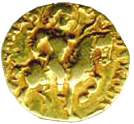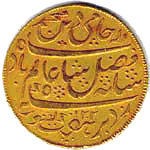 IST,
IST,
Others
This page proposes to carry information which may not fall into the formal structure of our coinage pages e.g. Indo-French Coins, Indo-Portuguese Coins etc., information related to coin designs, motifs, minting techniques as well as various facets of the history of Coinage.
Couplet Coins
Throughout history, despite protestations of artists to the contrary, there has been a close though uneasy and tenuous nexus between the Muses and Money. Coins have been a very powerful medium for projecting the art of contemporary engravers to the populace in general. The motifs have varied from portraits of royalty, personalities, heroic deeds, fauna and flora motifs, to allegories, etc. In an interesting innovation, ancient Indian coinage dovetailed poetry with the engraver's art, thus embellishing the visual message with verbal art.
Poetic legends (largely eulogistic) were introduced on coins by the Guptas (3rd to 6thCentury AD). For instance, the horseman type coins of the Guptas carried the following legend in poetic meter:
Guptakulamalachnadro Mahendrakarmajito
i.e. 'The Spotless Moon in the firmament of the Gupta family,
invincible, valorous as Mahendra, conquers the enemy'.

Similarly, the gold coins of Chandragupta II, carried the legend in the Vamsthavilameter:
Narendra chandrah prathita rano rane
jayatyajayyo bhuvi sinhavikramah
'The Moon amongst Kings, famous for his warfare,
valorous like a lion, invincible and victorious on the battle-field'
The Medieval period saw the gradual phasing out of pictorial and iconic motifs which were replaced by abstract designs and calligraphy. These art forms were especially conducive to making coins a medium for carrying the Poetic Muse. The messages, however, remained eulogistic - towards the greater glory of the King. Coins of Muhammed Shah II (AD 1442-1451), the Sultan of Gujarat carried the following couplet is an early example.
Sikka-e-Sultan Ghiyas-ud-din Muhammed Shah bad
Ta ba-dar-uz zarb gardun qurs-e-mihir-o-mah
May the coins of Sultan Ghiyas-ud-din Muhammed Shah remain
As long as the Mint of Heaven, the sun and the moon remain
Such poetic traditions were carried forth by the Mughals and by the time of Aurangzeb couplets became an intrinsic part of coin design. The Emperor Jehangir, struck coins in the name of the Empress, Noor Jehan, (the Light of the World) and the couplet quaintly read:
Ba hukma Shah Jehangir yafta sad zevar
Ba nam-e- Noor Jehan badshah begam zer
[Coin struck] by the order of Shah Jehangir, [This] gold hath a hundred beauties gained
with the inscription of the name of Noor Jehan, the Badshah Begum (Empress)
The East India Company carried on the tradition of poetic couplets. This mohur struck in the name of Shah Alam II at Mursheedabad carried the following couplet
Sicca zad bar haft kishwar saya fazle ilah
Hami deen-e- Muhammed Shah Alam Badhshah
Coins struck by the defender of the faith, Shah Alam by the Grace of God,
May it be current throughout the seven climes
With the issuance of the English type of coins in 1835, this tradition gradually came to an end.











